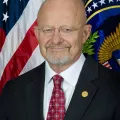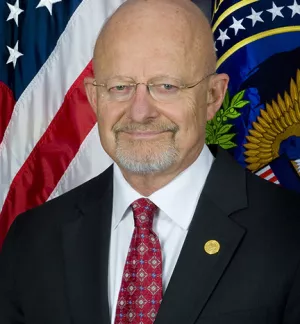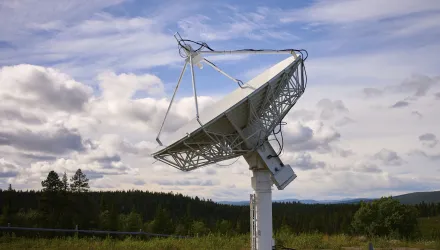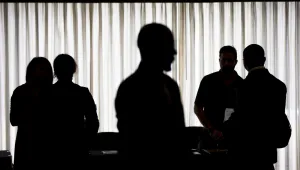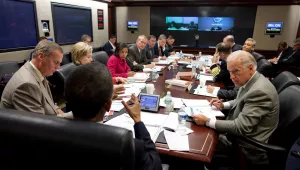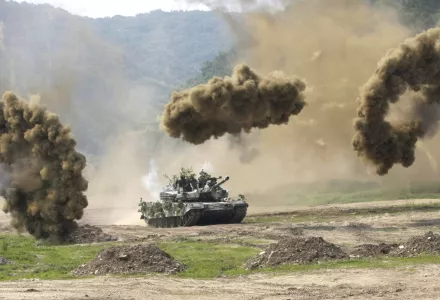
In his new memoir, Clapper recalls his time as a brigadier general serving in South Korea, where he got a good look at the paranoid, trigger-happy Hermit Kingdom.
That December [1984] the Air Force published the names of those nominated for promotion to brigadier general, and I was on the list. I was shocked. My parents and family were very proud, and Sue and Andy got ready to move again. I anticipated returning to the Pentagon as the deputy to the Air Force assistant chief of staff for intelligence, since that position was vacant, but then we got a second surprise: The Air Force was assigning me to be chief of intelligence for US forces in South Korea. My first thought was an old saying I’d heard from my dad: “There are four things in life you want to avoid: pyorrhea, diarrhea, gonorrhea, and Korea,” but I learned just how little influence brigadier general selects have over their destinies.
I reported to Seoul in June 1985 and quickly discovered the obvious— although the position in South Korea was designated for an Air Force officer, it was a job much better suited to an Army officer. It was a humbling experience as a new brigadier general to ask my team of Army colonels to mentor me on things like how to properly roll up the sleeves on my camouflage battle dress uniform. They also helped with Army slang and terminology used around the post, where initially I was almost as lost as I had been when I first reported to Tan Son Nhut Air Base as a lieutenant. I found that I was not just the senior intelligence officer for US forces, but also the deputy to a Korean Air Force two-star in the US–South Korea Combined Forces Command, someone who knew very little about intelligence and was looking to me for guidance. Fortunately, both of the Republic of Korea (ROK) generals whom I served as deputy were capable, smart, and easy to work with, and we eventually found our way.
My “big boss,” Commander of US Forces Korea, Army four-star general Bill Livsey, had been a lieutenant platoon leader with the 3rd Infantry Division during the Korean War and dug in on the front line when the armistice took effect on July 27, 1953. He knew his business and suffered no fools. He was salty, and in the tradition of General George Patton, excelled at colorful profanity when the occasion called for it. On day one, he made it very clear that the Korean War had never formally ended, the 1953 armistice was just a cease-fire agreement, and North Korea could, and would, invade the South if given the opportunity. From that premise, he gave me his very clear expectations for intelligence. He demanded forty-eight hours of warning ahead of a North Korean attack to give him time to activate the operations plan for the defense of the peninsula and to evacuate all US dependents in South Korea. And because taking those irrevocable actions would have huge diplomatic consequences for the United States and major political implications for the ROK, Livsey required a forty-eight-hour “unambiguous” warning—we had to know for certain that an attack was imminent, and not a bluff or a feint. General Livsey was not one for subtle nuance.
Andy enrolled at the Seoul American High School, whose wonderful principal, Sue Jackson, delivered a classic line at our first parents’ town hall: “I’ll make a deal with all of you. We’ll take with a grain of salt any stories we hear about what happens at home, if you take with a grain of salt any stories you hear about what happens at school.” We found the South Koreans generously warm and hospitable, somehow discovering our preferences and catering to them without our asking, and on our birthdays, sending enough flowers to make our house look and smell like a funeral home. As an eighth-grader, Andy took the subway in Seoul alone without our ever worrying, and we’ve always joked that Sue earned her black belt in shopping in Seoul’s famous Itaewon shopping area, not far from the Yongsan Army garrison where we were stationed in Seoul.
As Sue and Andy got settled, and as Jennifer was starting college in Virginia, I began to try to understand the operational situation. I read all the intelligence reports I could get my hands on and memorized the North Korean order of battle. While I had mastered the details, I was having trouble seeing the larger picture. One day, I was talking with one of my senior civilian intelligence analysts and asked for his advice on how to gain a broader, more strategic perspective. He suggested I visit the post library at Yongsan to read the official US Army history of the Korean War. I ended up spending several Saturdays there, immersing myself in the archives.
At the Pentagon I’d often heard the military truism that every nation is preparing to refight its last war. Militaries are led by bureaucracies that want to prove they’ve learned from their past mistakes, and they’ll apply those lessons to whatever situation they encounter next. The North Korea of 1985, much like the North Korea of 2018, was stuck in the paradigm of warfare in 1953. From reading the official history, I gathered that’s why leaders of the Democratic People’s Republic of Korea amassed their forces and supplies along the north edge of the DMZ—so they wouldn’t be reliant on a lengthy mobilization and extended lines of communication.
Also, because they remembered the impact of US carrier aviation during the war, they maintained two separate attack submarine fleets, one on each coast. Importantly, I read about the North Koreans activating two corps-level command-and-control entities not long before they crossed the 38th parallel on June 25, 1950, to manage their invading divisions, and so I considered that an important indication of a potential invasion.
Correlating the history I’d learned in the library with the daily intelligence reports, with help from a couple of my senior Army colonel mentors, I developed a briefing to explain the local situation to distinguished visitors, and I tested it on General Livsey. He liked the presentation, and even more, my starched battle dress uniform with glistening paratrooper boots and properly rolled sleeves. I think he had decided to consider his Air Force one-star as a reclamation project, so he took a personal interest in me. He enjoyed trotting me out and proudly pointing out to his Army general contemporaries “his” Air Force intelligence officer, who looked and talked so very Army.
Still, on at least one occasion, I proved to be pretty clueless. Among my responsibilities as the senior intelligence officer was oversight of what was called the Eighth Army Tunnel Neutralization Team (or TNT), a small contingent of US Army soldiers attached to an ROK Army engineer battalion. This joint unit was tasked with searching for DPRK tunnels under the Demilitarized Zone, which we assessed they planned to use to sneak Special Operations Forces into the South in the first stages of an invasion. Over a period of years, three such tunnels had been found, one of which had become both a major tourist attraction and a required visit for all military-age males in the ROK. Finding a fourth tunnel would have had huge domestic political impact and so was a high priority for the ROK government.
The major role of the Tunnel Neutralization Team was to provide intelligence to the ROK Army engineer battalion, which used several water- well rigs to drill wherever we assessed a tunnel might be. The battalion searched whenever we got reports of underground compressor or drilling sounds, or when shreds of burlap, which were used to line the tunnels, turned up in nearby rice paddies. We tried to apply seismic detectors as well, but the geology near the DMZ was very “noisy.” I once inquired how many holes had been dug and was told 3,400—more than 13 holes per kilometer along the 254-kilometer length of the DMZ. I suggested that if we tore off the peninsula along the resulting perforated line, it would eliminate the tunnel threat. My ROK friends didn’t find the remark amusing.
One day in early December 1985, the commander of the US TNT detachment, Lieutenant Colonel Gary Kratovil, a career military intelligence officer with a master’s degree in geology, came to my office to tell me, rather animatedly, that his team had located a hot prospect for the fourth tunnel. He asked me to visit the drill site both to see what his team and the ROK Army engineers had discovered and to flash my new brigadier general star to motivate the US and ROK troops. On December 17, 1985, a date I’ll never forget, we boarded a UH-1 “Huey” helicopter for the short ride from the Yongsan military garrison in Seoul up to the DMZ and the drill site.
The Huey was fully loaded, with two Army pilots, Command Sergeant Major Ray Oeth, Colonel Del Morris, deputy US Forces Korea command engineer Lieutenant Colonel Mike Rodrigues, Gary, and me. I had earphones and could listen to the pilots conversing, but did not have a map. Gary had a map, but couldn’t hear the cockpit. As we learned, this was a less than optimal arrangement.
It was a thirty-minute ride to the drill site in the Chorwon Valley—the nominal center of the peninsula and one of the two major invasion corridors when the North Koreans streamed south in June 1950. As we approached the site, the pilots were unable to establish radio contact with the soldiers on the ground. It was a clear day, and we were flying under visual flight rules rather than using instruments and navigation aids. Even so, pilots were required to have both radio and visual contact when flying or landing near the narrow DMZ. The copilot, Chief Warrant Officer 2 Concetta Hassan, who had led a Horatio Alger–type life and had already been the subject of a made-for-TV movie a few months earlier, was on just her second flight mission since arriving in the ROK. Through my headset, I heard her suggest that we fly higher to gain radio comms. The other pilot agreed and ascended three hundred feet. Sure enough, we heard our contacts at the landing site. Unfortunately, during the maneuver, the pilot lost sight of the pond that served as the major landmark in the area, and inadvertently lined up on another pond—just north of the DMZ. I began to hear a sound like popcorn in a microwave, and looked out the side of the aircraft to see white puffs below us. At about the same time, I heard a very loud, persistent, and annoying automated broadcast coming through my earphones: “Red Dog Fox! Red Dog Fox!” repeated over and over, which meant someone had crossed the DMZ. That someone was us.
Up front, CW2 Hassan took the controls, dove, turned, and after some evasive maneuvering—an unnatural act for a Huey with a full load— wheeled us around and got us back to South Korean airspace. Her maneuvers used a lot of fuel, and because we’d already traveled a long distance, we landed at a field-deployed rubber fuel bladder, gassed up with the rotor blades still turning, and then returned home to Yongsan. We didn’t find out until the helicopter was back in its hangar that a round had penetrated its main rotor. Miraculously, the rotor stayed intact on the leg back to Yongsan, even with the weight of the additional fuel and a full passenger load. From the helicopter pad, my driver was waiting to take me back to my office, and I matter-of-factly told Gary that we’d need to reschedule the trip, since we never made it to the drill site. Still shaken, he gave me a quizzical look.
When I walked into my office, the red phone, a direct emergency line to the around-the-clock command post, was ringing. I had been in Korea about six months, and that was the first time it had ever rung. On the other end was a duty officer, who told me, “My God, sir, we thought you were a goner.” After I assured him we were fine, another phone rang, a direct hotline from General Livsey. I braced myself and answered, and what followed made General Pfautz’s Sunday morning phone call in Virginia seem like a pep talk. At high volume, General Livsey instructed me on an important distinction between practices of the Air Force and the Army. In the Air Force, the senior pilot is designated as aircraft commander, the official in charge of the safety of the aircraft, regardless of the rank of any passengers. That was not the case in the Army, so thereafter, whenever I flew as the senior-ranking officer in an Army helicopter, I made sure I always had a map and headphones and knew where I was.
To General Livsey’s relief, the incident didn’t get much media play outside of Korea. The United Nations Command conducted a standard investigation and conveniently determined that we’d only made a shallow penetration of the DMZ. A few days later a nervous ROK Army regimental commander showed up at my office to apologize. The incident investigation determined that the round that hit the rotor was from an M60 machine gun, a weapon the DPRK didn’t have. The commander explained that the rules of engagement called for ROK Army elements along the DMZ to assume that any aircraft flying north was defecting and to shoot them out of the sky. We’d been taking fire from both the north and south, and it turned out the ROK soldiers were better shots. I went home that night and hugged Sue and Andy.
I continued to study and to work at absorbing Army culture. I became more adept at reading General Livsey and grew to admire the way in which, with his Georgia accent, he conveniently played the “dumb Southern boy,” though I knew he’d graduated first in his class from the Army’s Command and General Staff College. When Secretary of the Army John O. Marsh visited and I gave him my well-honed briefing on North Korea, Marsh asked how I felt about serving as an Air Force officer in what was essentially an Army position. I told him I appreciated the institutional commitment the Army had made to intelligence and that I’d learned a lot about the intelligence profession by seeing it from the viewpoint of another service. I didn’t know it yet, but assigning midgrade and senior officers to “joint duty” tours across services would be one of the major features of the Goldwater-Nichols Act in October 1986, an effort in which Marsh was heavily involved.
As the senior intelligence officer in Korea, I eventually grew confident enough in my understanding of the situation that I could honestly admit to General Livsey that we could not meet the expectation he’d demanded of me on day one. I’d become convinced there was simply no way to provide him with an “unambiguous” warning that North Korea was going to attack. I told him the only unambiguous sign he would have is when North Korean artillery shells started falling on Seoul. He didn’t like my answer, but he accepted it. I also came to believe the whole idea of having warning before North Korea executed a planned invasion was moot, as the much more likely circumstance leading to a conflict would be some small incident spiraling out of control.
Thirty years passed between when I reached that conclusion and my diplomatic visit to North Korea as Director of National Intelligence in November 2014. As control of the regime passed from Kim Il-sung to Kim Jong-il to Kim Jong-un, my personal assessment of the threat posed by the Hermit Kingdom never changed. If anything, the actions and the public pronouncements of the “Dear Leaders” over the decades reinforced my conclusion that none of them wanted to go back to fighting, but that they’ve kept the mechanics of war set on a hair trigger, and that any sane US policy on North Korea needed to be based on an understanding of that dynamic.
There is an unwritten, almost sacred writ of the intelligence profession that we in intelligence should avoid engaging in policy formation or execution. We support policy makers by providing them timely, accurate, relevant, even anticipatory intelligence, but we don’t participate in making the policy sausage. Our objective typically is to reduce uncertainty for decision makers as much as possible, whether they’re in the Oval Office, at the negotiating table, or on the battlefield. As DNI, I was careful not to advocate for specific policies in National Security Council meetings. However, Korea was one issue on which I let President Obama know—privately—that I thought his policy rationale of not discussing anything else until North Korea agreed to end its nuclear capability and ambitions was flawed, and after my 2014 mission to North Korea, I discussed my observations and views with analysts and policy makers in the national security field.
I had not fully appreciated the consuming siege mentality that pervades North Korea until I visited and engaged directly with senior officials there. The leadership elites in the North work hard to maximize paranoia among the population. Portraying the United States as an enemy that’s constantly on the brink of invading it is one of the chief propaganda themes that’s held North Korea together for the past sixty years. They are also deadly serious about any perceived affronts to the Supreme Leader, whom they literally consider a deity. The DPRK is a family-owned country and has been that way ever since it was founded in the 1940s. Because of its history, the DPRK sees developing nuclear weapons as its insurance policy and ticket to survival. North Korea wants to be recognized as a world power, and its entire society, including their conventional military forces, suffers for the relentless, single-minded commitment to develop and field these weapons and delivery systems to threaten the United States. Neither they nor we really know if their weapons work, but in many ways, it doesn’t matter. They achieved nuclear deterrence long ago, because we have to assume that if they do launch an ICBM at the United States, it will reach our shores and detonate. They have effectively played their nuclear hand to the hilt, for without even proving they have the relevant capability, they’ve capitalized on nuclear deterrence.
I believe, and have advocated, that to counter North Korea, the United States needs to consider capitalizing on our greatest strengths: openness and information. The DPRK survives because it fosters isolation. Outside the ruling clique, there is great interest in the outside world. Currently, we have limited means to satisfy their citizens’ hunger for information, something very difficult to do in the absence of a physical presence in the country. If we set aside for a minute our demand that they disarm before we’ll talk, we could establish a presence in Pyongyang in the form of a US “interests section,” modeled on the one we maintained in Havana for decades to deal with the Cuban government we didn’t recognize. We would not need to present this as a reward for bad behavior, but rather as an opportunity for direct physical access, which would enhance our insight and understanding and, perhaps even more importantly, foster interaction with the people of the DPRK and enable the flow of information from the rest of the world. We would, of course, reciprocate by allowing them to establish a similar mission in Washington. I don’t think this would represent a huge leap over their existing presence in the United States at the United Nations in New York.
I’m not naïve about the existence of formidable antibodies in the US government to what I’m suggesting, but I don’t see any other way to resolve the impasse. The DPRK won’t budge because they see us as an existential threat. If we are going to get out of the static, adversarial holding pattern we’re in now, we have to be the bigger partner and make the “breakthrough,” to use the preferred term the North Koreans used with me.
At this writing, the situation in North Korea seems poised for change—whether for better or for worse remains to be seen. Events and pronouncements in the first year of President Trump’s administration, including increasingly successful DPRK ballistic missile tests and an apparently successful thermonuclear test, heightened tensions between our two countries. Taunts between Trump and Kim Jong-un only serve to shorten the fuses of the military forces on both sides, as the DPRK Army stands ready to rain fire down on the 10 million residents of Seoul at a moment’s notice. Then, in March 2018, a South Korean envoy in Washington informed President Trump that Supreme Leader Kim was willing to discuss giving up North Korea’s nuclear program. Surprising everyone, Trump accepted the invitation to talk.
What I would hope (but doubt will happen) is that the United States will enter talks with a long-game strategy in mind. America has had a substantial military presence on the peninsula for almost sixty-eight years. If we can figure out a way, over time, with sequenced, mutually verified steps, to lead the DPRK government to where they don’t feel so threatened, we could move away from the rhetorical cusp of a cataclysmic war. If we can offer a road map to the US military’s withdrawing much of its forces from the peninsula, while the North Koreans reduce the large conventional forces they have along the DMZ, including the huge artillery and rocketry forces that are dug in ready to fire on Seoul, that would de-escalate the situation and lessen the danger of a minor incident quickly escalating to nuclear war.
In the late 1990s, when I was out of the government, I participated in the so-called Track II dialogue with members of the North Korean UN mission in New York. Over a dinner, one of the North Koreans spoke about transforming the United Nations Command into a peacekeeping force, to serve as buffer between the North and the South. So even they have considered a different arrangement on the peninsula. A reasonable first step might be to meet their demands for a peace treaty, as all we have now is a cease-fire, which began when the warring sides simply stopped shooting. In their minds, the war could resume immediately. We remain stuck on our narrative, and they are (or perhaps merely have been until recently) stuck on theirs. Only the bigger partner can change those narratives. I hope we can think ambitiously and be willing to go long, and perhaps this is our opportunity to do so. Unfortunately, I don’t think we’re postured—either philosophically or bureaucratically—to achieve that.
Clapper, James R. . “Kim Jong Un Is a God in North Korea.” The Daily Beast, June 1, 2018

